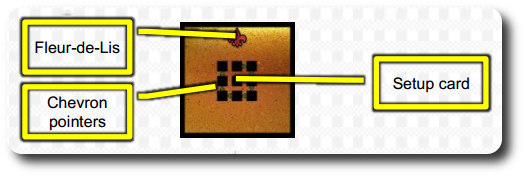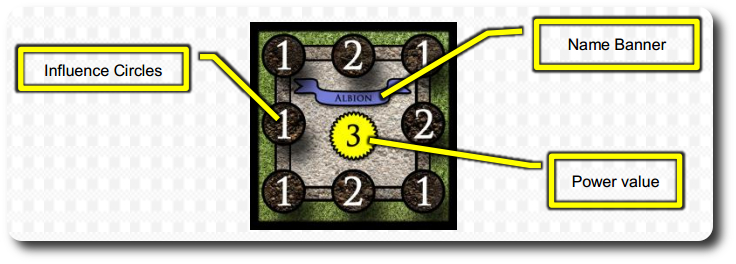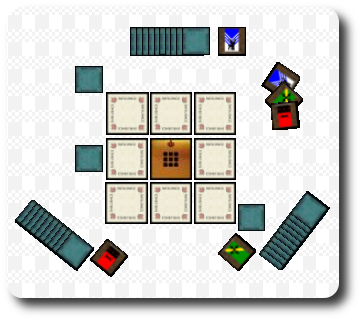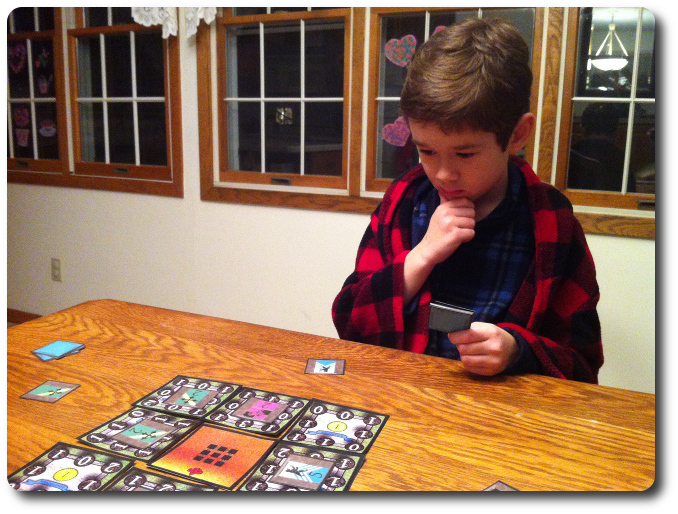Please Take Note: This is a review of the game’s final prototype. The art, game bits, and the rules discussed are all subject to change. The game is being reviewed on the components and the rules provided with the understanding that “what you see is not what you might get” when the game is published. If you like what you read and want to learn more, we encourage you to visit the game’s web page or the Kickstarter campaign page. Now that we have all that disclaimer junk out of the way, on with the review!

The Basics:
- For ages 10 and up
- For 2 to 6 players
- Variable game lengths (about 10 minutes per player)
Geek Skills:
- Counting & Math
- Logical & Critical Decision Making
- Strategy & Tactics
- Hand/Resource Management
- Pattern/color matching
- Cooperative & Team Play
- Bluffing and Misdirection
- Area Control
Learning Curve:
- Child – Moderate
- Adult – Easy
Theme & Narrative:
- Grab the ear of nobles and control mighty castles all through the art of influence
Endorsements:
- Gamer Geek approved!
- Parent Geek approved!
- Child Geek rejected!
Overview
The art of diplomacy and intrigue is only mastered by those who are truly devoted to the craft. Subtle is the brush that gently paints hints and suggestions into the minds of influential leaders. If done correctly, a single masterful stroke is worth a thousand soldiers and a well-timed flourish of words can bring down castle walls. It is a dangerous game full of lies and treachery, but the rewards are nothing short of the Keys to the Kingdom and worth the risk!
Influence, by TwoMonkeyStudios (LLC), will reportedly be comprised of 16 Castle cards, 5 Set Up cards, and 72 Faction cards. There are 6 different Faction sets. A complete Faction set has 6 Influence cards, 1 Delay card, 1 Saboteur card, 2 Swap cards, and 2 Faction ID cards. Not included in the game, but necessary to play, is a pen or pencil and a piece of paper to keep track of player scores. Note that this is a review of a prepublished game and the components provided represent the game’s final prototype. The number of game components and the final component quality will be based on the level of support provided during the Kickstarter campaign.
Game Set Up
Note: The following game set up is for Free-For-All game play where all the players are competing against each other. Team game set up is described in the Game Variant section below.
To set up the game, first hand to each player a complete Faction set (12 cards in total). Each Faction has a unique symbol which will make it easy to organize and separate the different Factions. Any unclaimed Faction sets are returned to the game box.

Second, players should now find the 2 Faction ID cards. These Faction cards just have an image of the Faction’s symbol with no number or other icon present. One of these two Faction ID cards is placed in front of the player, face-up, to identify what Faction the player is controlling. The other Faction ID card is given to one player who collects all the remaining Faction ID cards to create the Turn Order deck. Set the Turn Order deck aside for the moment.
Third, as a group, decide to either randomly select a Set Up card or collective agree on one. Set Up cards show the number of Castle cards that will be in play, the pattern they are placed, and the flow of influence (noted by chevron pointers). The number of Castle cards that can be in play range from 8 to 17. Obviously, playing space might limit the choices available to the players. Place the selected Set Up card in the middle of the playing area, face-up. Return all the other Set Up cards to the game box.

Forth, shuffle and place the Castle cards, face-down, around the Set Up card. The Castle card placement is defined by the Set Up card making this step a simple exercise in pattern matching. Any unused Castle cards are returned to the game box.

When completed, the game set up might look something like the following. Note that the Set Up card showed 8 Castle cards.

That’s it for game set up! One players should be in charge of the Turn Order deck for the game to make game play easier. Once that individual takes the Turn Order deck, the game can begin.
A War of Leverage
The game is played in 6 rounds with each round broken down into four phases. The phases are summarized here.
Phase 1: The Attack Phase
During this phase, each player will secretly select one or more of their Faction cards and place them next to a Castle card, the Set Up card, or a Faction card the player owns. The cards they play will impact the round and influence the final outcome of the game, no matter what card they play. This might seem rather stressful, as each card in the player’s hand can only be used once, and once played, permanently alters the balance in the game. Sometimes the balance of Power is in the player’s favor immediately, sometimes the balance is slow to shift, and sometimes the player can completely change the playing area benefiting no one. The cards available to the player are summarized here.
- Faction Influence cards: These cards have a number value of 2, 3, 5, or 6. The higher the number value, the stronger the influence. The more influence, the more Power the player can claim. At least one Faction Influence card, and no more than one, must be played per Attack phase by each player, face-down. During the first round, players can only play their Faction Influence card on a Castle card that does not have any other Faction card played on it. During the second and subsequent rounds, players can place a Faction Influence card on a Castle that they or their team has an Influence card on or on a Castle card that is adjacent to a Castle card the player or team controls.
- Faction Saboteur cards: These cards temporarily stop a player from obtaining additional support and Power from a neighboring Castle card that would otherwise help support their efforts. The Saboteur card cannot be played during the first round and can be played with Faction Influence and Faction Swap cards. Saboteur cards are played face-up and can be placed on any Castle card. When placed, the player declares which Influence Circle (a set of 8 numbers that surround the Castle card) the Saboteur card is being played on.
- Faction Swap cards: These card can be used to (1) switch Faction Influence cards, (2) rotate a single Castle card, or (3) rotate the Set Up card. The Swap card cannot be played during the first round and can be played with Faction Influence and Faction Saboteur cards. Swap cards are played face-up to the Set Up card only if there is no other Set Up card on it currently, to a Castle card that the player controls with the Faction being played (but does not have a Saboteur or Swap card already on it), or to any face-down or face-up Faction Influence card that belongs to the same Faction.
- Faction Delay cards: These cards are used to alter a player’s position in the turn order sequence.
The player who is controlling the Turn Order deck will now shuffle the deck and draw 1 Faction ID card, revealing it. The player who owns that Faction now plays one or more of their Faction Influence cards to the playing area. If the player likes, they can play their Faction Delay card when their Faction ID card is revealed. This will return the Faction ID card to the bottom of the Turn Order deck and the Faction Delay card is permanently removed for the duration of the game.
After all the players have placed their Faction cards, the Attack phase is complete.
Phase 2: The Swap Phase
During this phase, all the played Faction Swap cards that were played are now resolved. Any Swap card played to the Set Up card is resolved first. Then, starting with the North most Castle card in accordance to the Set Up card’s Fleur-di-Lis, any Swap cards on that castle are resolved. Finally, any Swap cards on any of the Influence cards located on that Castle card are resolved. Then the next Castle card is resolved in the order directed by the Set Up card.
- If the Swap card was played on the Set Up card, the player rotates the Set Up card 0, 90, 180, or 270 degrees.
- If the Swap card was played on a Castle card, the player rotates the Castle card 0, 90, 180, or 270 degrees.
- If the Swap card was played on an Influence card, that Influence card and another Influence card belonging to the same Faction switch places. If one of the swapped Faction Influence cards is face-down, it remains face-down at this time.

Once a Faction Swap card is resolved, it is removed for play for the duration of the game.
Phase 3: The Conquer Phase
During this phase, the total influence is determined for each Faction across the different Castle cards that make up the kingdom. This is done by starting with the “North” most Castle card to the Set Up card. The Set Up card has a small Fleur-de-Lis symbol that points “North”.
Staring with the first Castle Card and going in the direction indicated by the Set Up card using the small green chevron arrows that show the Castle card order, the number values on all the Faction Influence cards for each Faction currently on it are counted up. All face-down Faction Influence cards are revealed at this time. If the Castle card has not yet been revealed and has at least 1 Faction Influence card on it, it is turned face-up and positioned so that the name of the castle is “North” of the Castle’s power value, in accordance to the Set Up card’s Fleur-de-Lis.
A Faction’s total influence is also strengthened if they control an adjacent Castle’s Influence Circle value, but only if there is no Saboteur card located on it. As the Castle cards can be rotated, players can use the different point values to improve their overall influence. The following image shows how the different point values influence the Castle cards next to it.

The player or team with the most influence over the Castle card scores the Castle’s Power value (noted in the middle of the Castle card) immediately. If there is a tie, no Faction is awarded the Power. If the conquering Faction didn’t control the Castle during the Attack phase, they score 1 additional bonus Power point and they get to decide which of the currently played Faction cards they control will become the new controlling card. The winning faction can choose to take one of their Faction Influence cards located on the Castle card to be the new controlling card, placing it in the middle. Previously placed Faction Influence cards that were the controlling card stay with the Castle card to be counted as influence points during subsequent rounds. A controlling card does not have any bonuses, and is only meant to show which Faction controls the castle.
This continues with the next Castle card in the order provided by the Set Up card.
Any remaining Swap or Saboteur cards in play are removed for the duration of the game once Power is scored for all Castle cards.
This ends the round. If the total number of rounds played is less than 6, game play continues with a new round starting with phase 1 noted above. If this was the sixth round, the game is now concluded.
Influential Supremacy
At the end of sixth round, and the final scoring of Power is completed, all the points earned are added together. The player (or team) with the most points wins the game.
Game Variant
Influence can be played two different ways. The first is describe above and is referred to as Free-For-All because all the players are going against each other. The second way the game can be played is with teams. Teams should have an equal number of players if at all possible. If not, one player will need to control two or more Factions to make sure both teams have an equal number of Factions in play. Note that a player who is controlling more than one Faction during the game must play each Faction as an individual group (i.e., cannot play the Faction cards from 2 or more Faction sets like a single set), but Power is scored and shared as a team.
To learn more about Influence and read the full rules, visit the game’s web page or the Kickstarter campaign page. You can also download a free Print-n-Play version of the game if you want to try the game for yourself.
Prediction
Influence is a deceptively simple game. The rules are not very complicated and the number of actions allocated to each player via the cards is limited to only four. Indeed, the game play is very straight forward and should be easy to teach. What will not be easy to teach is how players should react to the shifting game play area. With the Swap and Saboteur cards, a player is never guaranteed points and will always have to fight to keep and maintain their influence over castles. Of course, that’s the game’s point and theme. In order to keep control of a castle, one must watch its walls and its neighbors.
Difficult.
But not so difficult that it is out of reach. The Gamer Geeks are going to enjoy this one, I have no doubt, as there is a lot of card management, strategy, and tactics. The Parent Geeks will enjoy it, I suspect, because of its relatively fast game play and very casual style. The Child Geeks are a difficult group to predict for Influence. Not because the game is beyond them, but because the shifting castles and points might be too difficult for them to keep track of, confusing and irritating them as a result.
And so, I taught the game to my 5-year-old and my 8-year-old to start out with. They were both very excited to play a game with “castles” and were very attentive during my explanation. About halfway through, I started to see my 5-year-old’s eyes glaze over. I’ll have to watch him carefully during the game. Despite what I interpreted as growing disinterest, my 5-year-old didn’t have any questions about the game and nor did his brother. As I set up the game for our first play, I asked them their thoughts on Influence so far.
“I really like how you have to fight for the castles and can work on several at the same time. I also really like how you can rotate them!” ~ Liam (age 8)
“It looks like fun.” ~ Nyhus (age 5)
My 5-year-old’s answer sounded a bit forced. That’s not good. Let’s play the game and see if my predictions were correct.
Final Word
I can sum up my 5-year-old’s experience with Influence in a word: “baffling”. He didn’t seem to understand the basic premise, despite him telling me over and over again that he did. He was confused about the castle rotations and placed his Faction Influence cards on Castle cards he couldn’t possibly win. He never got the hang of the game and left the table feeling disgruntled. Clearly, Influence is not a game that can be played with my 5-year-old yet. It took my 8-year-old a few tries to get the game, but he stuck with it and ended up being a pretty good player. He didn’t find the experience a good one, however, and never really fell in love with the game. We played Influence with one other 8-year-old, and the results were the same. The majority of Child Geeks showed a slow but steady growing understanding of how the game worked, meaning the learning curve for Child Geeks is about “moderate” as a result. This surprised me as I didn’t see anything in the game that would suggest a lot of difficulty. The game was rejected by the Child Geeks because they never really got to a point where they enjoyed it before looking to play another game.

My oldest little geek kept at it, but he never fell in love with the game
Parent Geeks, on the other hand, did like Influence. Take note, however, that Influence was not enjoyed by the non-gamers. For those Parent Geeks who had a number of casual games under their belt, they were able to learn and enjoy Influence almost without effort. Everyone else worked for it, but the overall learning curve was most certainly “easy”. The trick for the Parent Geeks was to keep in mind that Influence was won through small battles that eventually added up to winning the war. “Divide and conquer” was often stated by the Parent Geeks and they really appreciated it. They voted to approve Influence.
While the Parent Geeks played Influence casually and socialized a great deal while they quietly took over their opponent’s castles, the Gamer Geeks were anything but. They were wonderfully cutthroat with each other, not at all shy about informing an opponent how much they disliked their plays, and greatly enjoyed twisting and turning the game to achieve points or stop their opponents from getting them. The Gamer Geeks said they saw Influence as a game of subtly, where plays were meant to move the game forward by inches to obtain small victories that add up to total domination. They loved it. The amount of tactics necessary and strategy when playing the Faction cards was well received. I should also note that the Gamer Geeks were the only ones to use the Delay card effectively. There is sometimes a great deal to gain when going first or going last in the Turn Order sequence.
Influence is a rather ingenious little game. It takes a very simple premise that would have been rather ho-hum, and added a great deal of depth to it. The level of focus it takes to play the game competitively is a challenge, and there is a great deal of strategy and tactics to be discovered. Since all plays to grab influence are blind until revealed, no player really knows where they stand until the end of the round. But the Swap card can be played on cards both revealed and hidden, causing players who are counting cards and keeping track of points to really furrow their brow. This also allows players to change their strategy almost effortlessly. Add in the ability to not only rotate the Castle cards, but also the Set Up card, and the players have a tremendous amount of control over the game’s flow. Usually such control would send the game into chaos, but the limited number of cards and short game span makes each play crucial. Rather than simply waste a card, we found that players attempted to use each for maximum effect.
The game is not perfect, however. If you select a Set Up card with too many Castle cards but not enough players, the game becomes very unimpressive as the players can duck and dodge each other with ease. The random Castle cards that are hidden until revealed keeps the players hunting for the big points, but there is little incentive to battle it out for a castle when there is plenty to go around. All that would be needed is a simple indicator on the Set Up cards that suggests the recommend number of players for each. Boom! Problem solved.
Influence is challenging and makes the players think. The game play is simple and complex at the same time. Simple in its execution, with the complexity almost entirely focused on trying to determine how each player is going to influence the round. This wasn’t lost on the Parent or Gamer Geeks, but it did make the Child Geeks feel lost. Just a bit too much going on and to keep track of for the younger and inexperienced players. For everyone else, it proved to be a great game and one that many wanted to play again. A fun mix of worker placement, resource management, and area control in an ever shifting abstract game. Neat!
This game was given to Father Geek as a review copy. Father Geek was not paid, bribed, wined, dined, or threatened in vain hopes of influencing this review. Such is the statuesque and legendary integrity of Father Geek.




Thanks for the review!
I wanted to take a minute to mention that we have incorporated the Number of Players onto Setup cards in the same fashion as 7 Wonders (i.e., a setup for four or more players will have “4+” on the card).
Additionally, the random values of Castle cards is addressed in a variant that I personally enjoy, where you hand-select all of the Castles with 1 Power, and shuffle/set up those Castles. This takes away some of the randomness, but the variety in Influence generated by each Castle maintains a good amount of mystery and intrigue.
We have a few extra cards as part of stretch goals that are not included in the core game primarily due to complexity. They’re great if you want the game to have more options in terms of Special cards, but I feel like they require having played the game once or twice before you really understand how to use them.
Thanks again for the review!
–matt